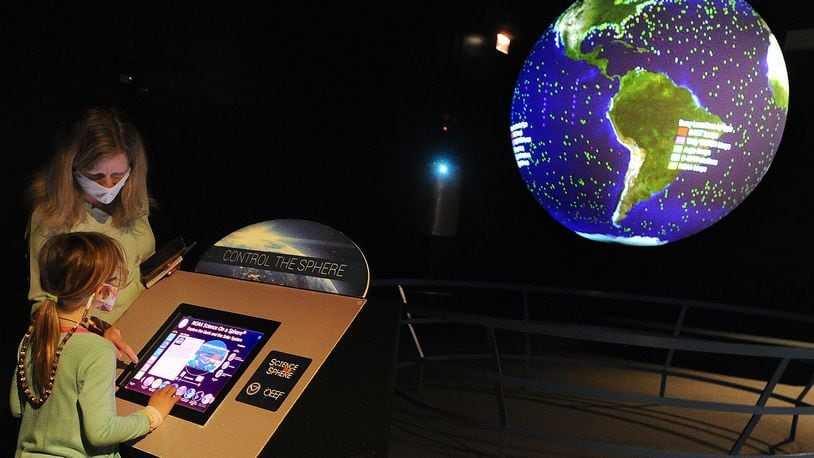“When we opened our attendance was sparse,” said Tracey Tomme, the museum’s president and CEO.
With millions of dollars in lost revenue during 2020 —$1.2 million in the case of the Boonshoft — museums and arts-related venues are looking to the $16.25 billion federal Shuttered Venue Operators Grant (SVOG) program to make up for lost revenues and keep themselves afloat.
“Getting a Shuttered Venue Operators Grant will be a game changer for how our year works out this year,” Tomme said. “There was a lot of confusion over applying for PPP funds and SVOG but it sounds like they have it all pretty well worked out and we will be able to apply soon.”
The Small Business Administration on Thursday is slated to start taking applications for the SVOG program, which was established under the federal Economic Aid to Hard Hit Small Businesses, Nonprofits and Venues Act signed into law Dec. 27. The program initially appropriated $15 billion toward struggling in-person industries, including concert venues and theaters that were forced to close due to COVID-19 restrictions and allows those businesses to apply for the grant and a PPP loan.
The American Rescue Plan Act, which was signed into law March 11, tacked on an additional $1.25 billion.
Most of the theater business has seen between 70% and 90% of its revenue dry up during the pandemic, according to Ty Sutton, president and CEO of Dayton Live, which owns and operates the Benjamin & Marian Schuster Performing Arts Center, Victoria Theatre, the PNC Arts Annex, The Arts Garage and Metropolitan Arts Center, home of The Loft Theatre.
“(It helps that) we have some monthly parking, we have some tenants in one of the buildings we own, but largely you’re trying to operate a business that’s closed with no revenue yet to have to keep staff on, you have to maintain the venues you own,” Sutton said. “It’s been incredibly difficult.”
Pandemic-related shutdowns and regulations have been a challenge to not only large venues, but also smaller ones such as 1,000-seat theaters, music clubs and others, he said.
“We’ve been shut down by mandate,” Sutton said. “That doesn’t mean you get to stop paying your bills, insurance, mortgages or rent.”
What it does mean is entertainment and culture industries have the highest level of unemployment in the country, he said. In Ohio, approximately 30 percent of workers are out of a job, with many of them seeking work in other industries, Sutton said.
“It’s been really challenging but what the grants mean is for people who do own venues that hopefully they’ll be able to reopen and not permanently close,” he said. “But across the country we’ve lost hundreds if not thousands of venues at this point.”
Shut down in 2020 from mid-March through the end of December, Dayton Live venues offered live streaming events before reopening under state mandate to 25% capacity, which ended up being even smaller once all the guidelines that needed to be followed were implemented, he said.
“In a typical year we’ll see at least a half million visitors and we’re seeing 1, 2, maybe 3% of what we would normally see right now,” Sutton said.
While total dollars from the city, county, city, state and federal has been helpful, “this (SVO Grant Program) is at least five times bigger than all of those combined,” he said.
“For someone like us who’s been borrowing money in order to keep the venues running at a basic level, we’ve cut out staff by over 80 percent at this point, it’s really the difference for us being able to reopen in a fairly healthy way,” Sutton said. “And when I say ‘fairly,’ we don’t know what kind of grant we will or won’t receive yet, but at least hopefully opening where we’re not trying to pay off the debt from the pandemic for the next 10 or 15 years.”
With hundreds of performances and private events lost, as well as millions of dollars in lost revenues, “it’s definitely been a very, very painful 13 months,” he said.
The SVO Grant is not only “a massive piece” of the puzzle when it comes to keeping various venues afloat, it’s also smart for the economy, he said.
“If venues like ours don’t come back then it takes even longer for the economy to recover, not just from the people we employ but from the fact that there’s a quality of life that comes from the kinds of things that we present to our community,” Sutton said.
COVID-19 definitely has been “an interesting time” for museums, said Tomme of the Boonshoft Museum of Discovery, which managed to create virtual educational content and continued to care for its zoo animals. It also made some internal changes like not replacing some staff that departed over the year, but with its zoo, collections and an aging building, there are some things it just has to do, she said.
“We’ve left some projects undone for now and asked donors to allow us to reclassify some restricted funds from projects to operations,” Tomme said. “With SVOG, we’ll be in much better shape. Without these types of funding opportunities, it’ll take years for us to recover.”
Entities that applied for a PPP loan after Dec. 27, 2020, can also apply for an SVOG, with the eligible entity’s SVOG to be reduced by the PPP loan amount, according to the Small Business Administration. The dedicated SBA webpage, www.sba.gov/svogrant, includes frequently asked questions, video tutorials and other SVOG details.
About the Author
